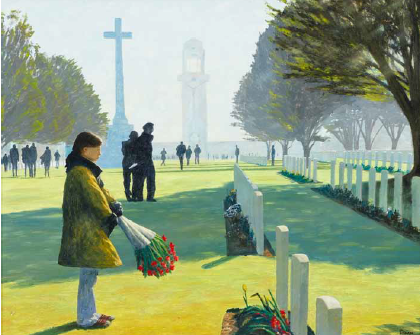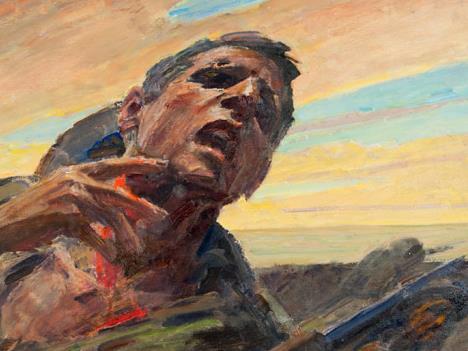Robert Hannaford, ‘Life, death, mateship’.
Television stations will be going to war for ratings come Anzac Day 2015 with three networks each in development of a new Gallipoli series.
For those who want art and film to reflect and explore an evolving Australian identity, the investment of such a chunk of energy and money in these three similar stories, is disappointing.
Screen Hub reports that Foxtel has commissioned The Gallipoli Story, four 60-minute episodes now in pre-production which follows the journey of war journalists, including Keith Murdoch. The ABC is at rough cut stage with ANZAC Girls, a six part mini-series about five women who volunteer as nurses in World War I. Nine Network is still in the pipeline with its offering, unimaginatively title Gallipoli, based on the book by Les Carlyon.
A generation on from Peter Weir’s 1981 Gallipoli, our filmmakers and program schedulers remain obsessed with an oft-told tale getting on for a century old.
Of course history is a valid and important subject for art and no one is denying that the tragic loss at Gallipoli during World War I was a formative experience for a generation of Australians. With the centenary in 2015, the temptation of a well-primed audience is too large for our networks to look further afield.
But Gallipoli is a constrained topic which has already been given ample treatment not only on film but in other art forms and the effort networks are expending in creating art to mark the anniversary shows little sigh of producing anything which really interrogates the myth.
Where is the work that examines why Australia chooses a story of epic failure as its national legend? Or what the story means – if anything – to the quarter of Australians born overseas and the many more whose families migrated in the mid- 20th Century, including 25,000 Turkish Australians?
With the approaching centenary in 2015, the obsession with Gallipoli is reaching fever pitch. The Gallipoli Art Prize was founded in 2006 as an annual $20,000 acquisitive award leading up to the centenary. The award asks artists to reflect on ‘loyalty, respect, love of country, courage and comradeship’. These are fine values but they have mostly found recognition in fairly traditional work filled with poppies, flags and uniforms, as the finalists below illustrate.

Aliyah Kadic, What makes me proud?

Garry Dolan, Quick Mum, Over Here, I Think I Have Found Him

Robert Keen, Generation Three
This year’s winner: Dog of War by Peter Wegner has a certain poignancy. But as an anti-war statement it has none of the power of, say, Alex Setton’s marble folded flags Six More, commemorating Australian soldiers killed in Afghanistan.
Peter Wegner, ‘Dog of War’, Winner of the 2013 Gallipoli Prize

‘Six More’ by Alex Setton, Australian War Memorial
I’d venture to suggest that the jingoistic nature of much Gallipoli art is a direct result of the way the Gallipoli narrative has been subverted into a national folktale. I don’t hold out much hope that these films will do anything different.
As storytellers, filmmakers like other creative artists do not merely illustrate our stories they decide what our stories are. Gallipoli is a story that defines this perspective as male, white, physical and anti-authoritarian. The ABC’s ANZAC Girls at least proposes to push one of these parameters but it still gives focus to the same period and perspective.
We are getting much better at finding and telling great Australian stories about what happens in our time and place and, of course, course most Australian stories happen in Australia and, excepting Indigenous stories, most are quite recent.
But it is also time we acknowledged the complex and varied nature of the ‘offshore history’ which plays into our identity.
Just 10 years ago, in 1993, Frank Moorhouse’s novel Grand Days was ruled ineligible for the Miles Franklin award because it was held not to meet the terms of Miles Franklin’s will which requires the winning work to ‘present Australian Life in any of its phases’. Grand Days is about an Australian diplomat working at the newly founded League of Nations and has a great deal to say about Australia on the world stage in the years after World War I but its language is the subtle power-play of diplomacy not the muscularity of the battlefield. (Moorhouse won when he brought Grand Day’ heroine Edith Campbell Berry home in The Dark Palace, in my opinion an inferior work).
Significantly last year the Miles Franklin went to Anna Funder’s wonderful work All That I Am, a thoroughly European story told through the eyes of a migrant Australian. I applaud this change. It’s time we realised that Gallipoli is not the only slice of Australian life played out on foreign soil.
A mature country has multiple narratives, reflecting the histories not just of those whose grandparents fought with the ANZACs but also those who fought different battles – or even fought on the other side.
The last World War I ANZAC died 10 years ago. Maybe the centenary is a good time to turn our attention to other histories.




